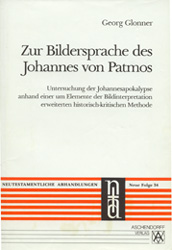This book, focused on four pericopes from Revelation but also including
broader discussion of the use of images in ancient apocalyptic literature
and its modern interpretations, is well written and very detailed. As the
subtitle indicates, Glonner basically applies standard historical-critical
methodologies, but the main contribution of this study is the careful analysis
of the symbolic images of Revelation and their connections with previous prophetic
and apocalyptic works.
Glonner first summarizes the literary features, historical contexts, and
theological aspects of Jewish apocalyptic, seen as an outgrowth of both the
wisdom and prophetic traditions of the OT. He then situates the Book of Revelation
clearly within this stream of Jewish apocalyptic writing, although he acknowledges
that it is unique in certain ways. Next, he discusses the role of images (Bilder)
in human life, suggesting nine "grammatical rules for the reading of images"
according to the revelatory, emotional, polyvalent, polarizing, timeless,
mediating, psychological, contrasting, and visual aspects (rules based on
I. Riedel, Bilder in Religion, Kunst und Psychotherapie: Wege zur Interpretation
[Stuttgart: Kreuz, 1988]). He also proposes four steps for the proper analysis
of the imagery in Revelation: to describe the images and their components,
to determine the origins of the motifs, to observe John's adaptation of the
motifs, and to grasp the message of the images. He argues that the images
in Revelation are taken mostly from the extensive imagery of the OT, while
some are influenced by nonbiblical apocalyptic sources (on which they are
not directly dependent). John's creativity as an author lies mainly in his
combination and adaptation of older Jewish images rather than in the creation
of new ones.
The four main chapters are comprehensive, well documented, and identically
structured, although G. never explains why he chose Rev 18:9-24 (the lament
over Babylon's Fall), 13:1-18 (on the two beasts), 4:1-11 (on worship before
the throne), and 10:1-11 (on the angel and the little scroll), respectively.
In each chapter, he first provides a German translation of the text followed
by a helpful synopsis of cross-references (listing Ezekiel, Daniel, other
OT and NT books, and Jewish apocalyptic sources in tabular format). Then he
applies textual and literary criticism, as well as criticism of form and genre,
to the pericope. Although not much is new in these sections, they are convenient
surveys of the pertinent critical issues. Each chapter contains detailed analyses
of John's imagery, especially of his use and adaptation of the pertinent images
from the older Jewish sources.
While many of G.'s detailed observations are convincing, no scholar would
agree with all of his interpretations. In chap. 2, he limits most of the discussion
to Rev 18:9-24, even though his own structural analyses suggest that the pericope
begins at 18:1. While G. often argues that the images of Revelation have connections
both to OT images and to contemporary historical events, he
sometimes dismisses historical allusions without convincing arguments. More
problematic is his unexplained assertion that the blood imagery of Rev 18:24
is related to Matt 27:25. Particularly interesting are his contrasts, in chap.
3, between the false worship of the beasts (Rev 13) and the true worship of
the lamb (Rev 5), and his interpretation of 666 as a generic symbol for the
Roman emperor rather than a particular individual. Problematic, however, is
his frequent but unjustified naming of the second beast as "the anti-Christ,"
which does not appear anywhere in Revelation.
Glonner's main point is that John not only stands within the stream of Jewish
prophetic and apocalyptic tradition but also sees himself as the last prophet
before the eschatological judgment. Moreover, G. argues that the sociohistorical
setting of Revelation involves not only the persecution of Christians by the
Roman authorities in Asia Minor but also the internal divisions caused by
the Nicolatians.
The many untranslated Greek and Hebrew words limit the reading of this revised
doctoral dissertation to scholars and advanced graduate students. However,
in chaps. 1 and 6 G. deals more broadly and less technically with the interpretation
of images. Each of the four exegetical chapters ends with a section of conclusions
in which G. summarizes the main points of that chapter. Similarly, the conclusion
of the whole book is a convenient summary of the main points presented in
each of the previous chapters. The bibliography is extensive, but the works
listed in it are almost all by German scholars. There is a comprehensive index
of citations from biblical and nonbiblical ancient sources, but unfortunately
there is no index of subjects. The number of typographical errors is fairly
small: some Greek words are mistakenly printed in Latin fonts (on pp. 79,
99, and 236), and there are a few errors in biblical references or in the
German text. Despite these minor problems, the book is interesting and well
worth reading.
 Zur Bildersprache des Johannes von Patmos:
Zur Bildersprache des Johannes von Patmos: